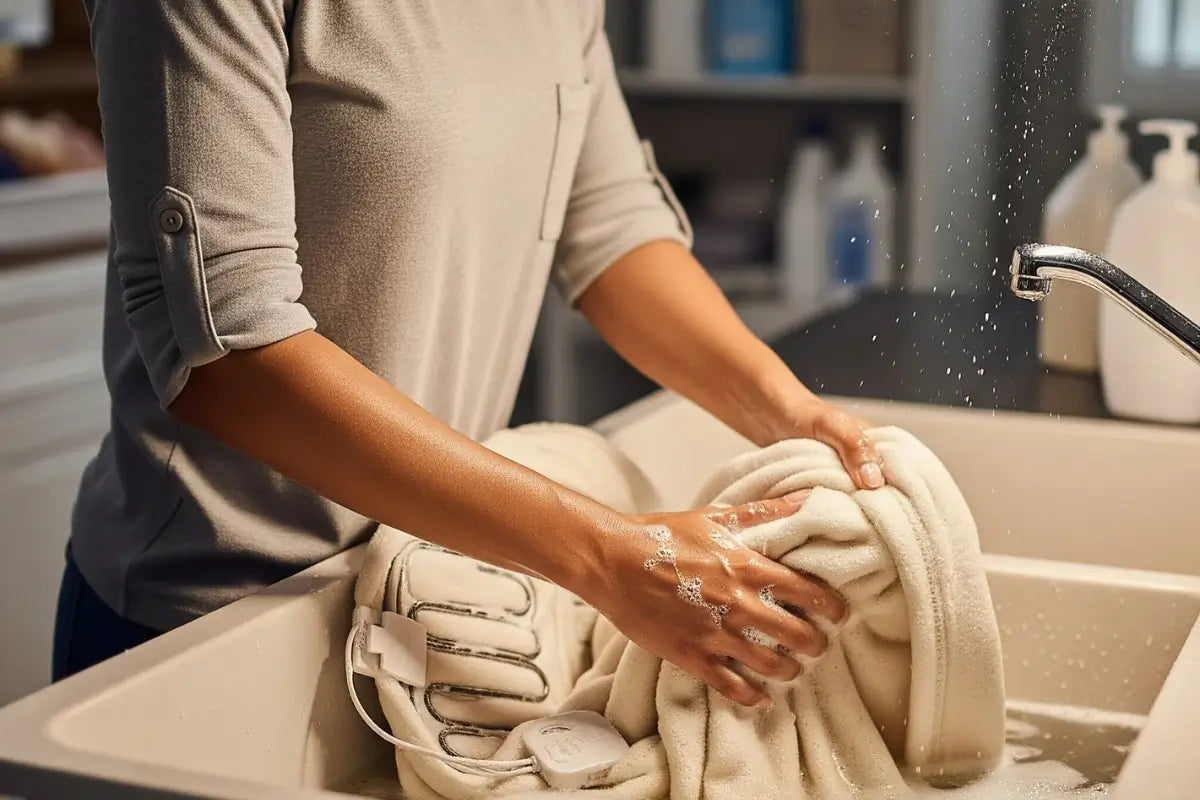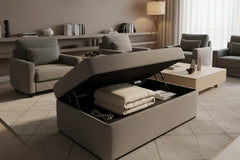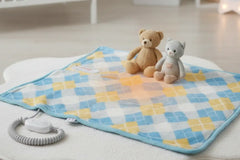How to Clean Heated Blanket Safely at Home

Heated blankets keep you warm and cozy, but they need care to stay safe and clean. If you ignore cleaning, dirt, allergens, and damage can build up quickly.
This guide will show you easy and safe ways to clean your heated blanket at home, so you can enjoy comfort without worries. Keep reading!
Table of contents
Key Takeaways
-
Always unplug your heated blanket before cleaning or inspection to ensure safety.
-
Regular cleaning removes dirt, allergens, and pet hair that can cause odors and affect warmth.
-
Use gentle methods and mild detergent; avoid bleach, fabric softeners, and harsh scrubbing.
-
Proper drying and storage prevent mold, wiring damage, and extend your blanket’s lifespan.
-
Regularly inspect your blanket for wear or electrical damage to keep it safe and working well.
Why Cleaning Your Heated Blanket is Important?
Maintains Hygiene and Removes Dirt
- Your blanket collects sweat and oils every night: Each night, your body leaves behind sweat and natural oils on the blanket. If not cleaned regularly, this buildup can make the fabric feel greasy and less fresh.
- Bacteria grow fast in dirty blankets: When sweat and body oils stay on the blanket, they create the perfect place for bacteria to grow. This can turn your warm, cozy blanket into a home for germs.
- Dust and pollen get stuck in the fabric: Heated blankets can trap tiny particles like dust, pollen, and even dust mites. These can trigger allergies or make your skin and breathing feel uncomfortable.
- Washing stops bad smells from developing: As dirt and body oils pile up, your blanket can start to smell. Regular cleaning keeps it smelling fresh and clean.
Prevents Allergens and Dust Mite Buildup
Heated blankets can harbor dust mites, pet hair, and allergens, which trigger allergies and respiratory issues. Regular cleaning reduces these risks and keeps your sleeping environment healthy.
Ensures Safe and Efficient Operation
Cleaning prevents buildup that could cause electrical malfunctions or fire hazards. Always unplug your heated blanket before cleaning or inspection to ensure safety.
Extends the Lifespan of the Blanket
Routine cleaning and proper care help maintain the blanket's electrical components and fabric integrity, extending its lifespan and saving you money on replacements.
Preserves Fabric Softness and Comfort
Cleaning your heated blanket preserves the softness and comfort of the fabric. Using gentle methods like spot cleaning with mild detergent and lukewarm water prevents damage to the delicate wires inside.
Avoid harsh chemicals or rough scrubbing, which can degrade the fabric texture and affect warmth and coziness.
Reduces Risk of Electrical Malfunctions
- Dirt in the blanket can mess with the wires: When dust and debris build up inside your heated blanket, they can press against the wires or controls. This makes the blanket more likely to short circuit or stop working properly.
- Moisture makes electrical faults more likely: If your blanket holds on to moisture from sweat, spills, or humidity, it can damage the wiring inside. Wet wires are risky and can lead to sparks or shocks while using the blanket.
- A dirty blanket can get too hot and become dangerous: Grime and blocked heat spots can make your blanket overheat. If it gets too hot, it can cause burns, or worse, start a fire.
- Washing the blanket helps keep the wiring safe: Cleaning your heated blanket removes the dirt and moisture that threaten the wiring. A clean blanket runs smoothly without putting stress on its electrical system.
Enhances Overall Sleep Quality
- Sleeping feels better when your blanket is clean: A clean heated blanket gives a cozy and healthy feeling that helps you relax faster and enjoy your sleep more.
- A dirty blanket can disturb your sleep: Dust and allergens in an unwashed blanket can make you feel itchy or uncomfortable, which makes it harder to fall asleep and stay asleep.
- Breathing is easier when your blanket is fresh: Washing your heated blanket removes things that can bother your nose and lungs, especially if you’re sensitive to dust or allergens.
- Clean blankets help you sleep without waking up: When your blanket is clean, you’re less likely to wake up feeling uneasy or restless during the night, leading to peaceful, deep sleep.
Signs Your Heated Blanket Needs Cleaning
Visible Dirt and Stains on the Fabric
- Stains block fabric breathability and reduce warmth: Heated blankets often pick up stains from food spills, sweat, or dirt from your skin. These visible marks don’t just look bad, they also block the fabric’s breathability and reduce its ability to keep you warm.
- Grime traps bacteria and allergens: When grime builds up, it traps bacteria and allergens in the blanket, making it less hygienic and potentially irritating to sensitive skin.
- Stains can damage internal wiring: Stains aren’t just a cosmetic problem, they can pose safety risks by affecting the wiring inside the blanket. This can lead to damage or even hazards if left uncleaned.
- Frequent use can lead to stains: If you use the blanket often, especially while eating or lounging, stains can appear quickly and frequently, making regular checks and cleaning essential.
- Spot-cleaning is key to preserving the blanket: To safely handle visible dirt, use mild soap and cold water to spot-clean. Avoid harsh scrubbing to protect the fabric and internal wiring from damage.
Unpleasant Odors Emitted When Heated
- Dirt, Sweat, and Oils Cause Bad Smells: If your heated blanket smells when turned on, it’s likely due to dirt, sweat, or oils that have built up over time. These substances create unpleasant odors once the blanket is warmed up.
- Mold or Mildew Can Create Musty Odors: A musty smell may indicate mold or mildew, especially if the blanket has been left damp. Moisture encourages the growth of these, leading to unwanted smells.
- Sweat Builds Up Odors Over Time: Sweat can make the smell worse, as it adds to the build-up of oils and dirt, intensifying the odor each time the blanket is heated.
- Regular Cleaning Prevents Smells: Cleaning your heated blanket regularly will help remove oils, dirt, and sweat, preventing unpleasant odors and ensuring it stays fresh when you need it most.
Reduced Warmth Efficiency Over Time
- Dirt Blocking Heat Distribution: If your heated blanket feels cooler than before, it could be due to dust and grime blocking the heat. These particles create barriers that stop warmth from spreading evenly.
- Cleaning Restores Blanket’s Warmth: A drop in warmth is often a sign that the blanket needs cleaning. Washing it carefully can restore its original heat distribution and improve comfort.
- Regular Cleaning Helps Maintain Warmth: Cleaning your heated blanket every few months, especially with frequent use, helps keep its warmth consistent. Regular washing prevents buildup that can reduce heat efficiency.
Build-up of Dust and Allergens
-
Dust and Allergens Accumulate Inside Your Blanket: With regular use, dust and allergens naturally build up inside the fabric and wiring of your heated blanket.
-
Visible Dust or a Dusty Smell Means Cleaning Is Needed: If you notice visible dust or smell something dusty, it's a clear sign that allergens have built up and cleaning is needed.
- Unpleasant Odors from Build-up of Allergens: A build-up of allergens inside your blanket can lead to bad smells, making your heated blanket uncomfortable to use.
Signs of Fabric Wear and Tear
- Thinning Fabric Weakens the Blanket: If you notice areas where the fabric is getting thinner, it means the material is losing its strength. This can reduce the blanket’s ability to protect its internal wiring.
- Pilling Affects Cleaning and Comfort: When you see small fuzz balls or pilling on the fabric, it can affect both the ease of cleaning and the warmth of the blanket. Pilling forms from wear and makes the surface uneven.
- Discoloration Indicates Fabric Wear: Yellowing or fading of the blanket’s fabric suggests it has been used for a long time and may need cleaning or even replacing. These changes indicate the fabric is wearing out.
Irritation or Allergic Reactions After Use
- Signs of Irritation from a Dirty Heated Blanket: If your heated blanket is dirty, it can cause skin irritation, like rashes or itching. Dirt, bacteria, and dust mites are common triggers.
- Bacteria Irritating Your Skin: Bacteria inside your blanket might not just smell bad; they can also directly irritate your skin and make it uncomfortable.
- Dust Mites and Mold Causing Allergies: Dust mites and mold thrive in warm blankets, causing sneezing, rashes, and other allergic reactions on your skin.
Accumulation of Pet Hair or Debris
- Pet Hair Can Block Heat and Reduce Efficiency: Pet hair often clings to heated blankets and can impact how evenly they heat. When hair and debris like dust or crumbs get trapped, they can cause cold spots and uneven warmth.
- Debris Buildup May Cause Damage to Wires: Pet hair and other debris can get into the wiring areas of your blanket, blocking ventilation and even potentially causing wiring damage, which could lead to a fire hazard.
- Regular Cleaning Keeps Your Blanket Working Safely: Cleaning your heated blanket by removing pet hair and debris helps it work more efficiently and safely. A buildup of dirt or hair may make your blanket less warm and could even damage the internal wiring.
How Often Should You Clean a Heated Blanket?
Cleaning frequency depends on use but generally ranges from every few months to twice a year. Spot cleaning can extend time between full washes.
Should You Unplug or Disconnect the Heated Blanket Before Cleaning?
Always unplug or disconnect the blanket from its power source before cleaning or inspecting to avoid electric shock or damage.
Can You Wash a Heated Blanket in a Washing Machine?
You can wash your heated blanket on a gentle cycle using mild detergent, but check the manufacturer’s instructions first. Never use bleach or fabric softeners.
Is It Safe to Hand Wash a Heated Blanket?
- Unplug the Blanket to Avoid Risks: Before washing, always unplug and disconnect the blanket to prevent any electric shock risks.
- Use Lukewarm Water and Gentle Detergent: Wash the blanket with lukewarm water and a mild detergent to protect the heating elements.
- Soak Gently Without Scrubbing: Soak the blanket carefully, but avoid scrubbing to protect the internal wires and heating parts.
- Avoid Long Soaks and Twisting: Do not leave the blanket soaking for too long, and never twist or wring it, as it can damage the heating system.

Can You Use Bleach or Fabric Softener on Heated Blankets?
Avoid harsh chemicals like bleach and fabric softeners, which can damage the wiring and fabric. Use mild detergents for cleaning.
How to Spot Clean a Heated Blanket Instead of Washing the Whole Thing?
For minor stains or spills, spot clean with a damp cloth and mild detergent. This helps reduce the frequency of full washes and preserves the blanket’s lifespan.

How Long Does It Take for a Heated Blanket to Dry Completely?
- Heated Blankets Take Longer to Dry Indoors: After washing, a heated blanket usually takes 4 to 6 hours to dry indoors, depending on the room’s temperature and airflow.
- Outdoor Drying Speeds Up the Process: If you dry the blanket outside on a warm, sunny day, it can dry faster, usually within 2 to 3 hours.
- Spot Cleaning Dries Much Faster: Spot cleaning a heated electric blanket typically dries in 1 to 2 hours since only small areas get wet.
- Removable Covers Dry Like Regular Blankets: If your blanket has a removable cover, it dries like a normal blanket, typically within 2 to 4 hours.
- Wires and Thicker Fabric Delay Drying: Heated blankets take longer to dry compared to regular blankets due to their wires and thicker fabric.
How to Store Your Heated Blanket After Cleaning?
Make Sure It’s Completely Dry
-
Ensure Your Heated Blanket Is Fully Dry: Prevent moisture buildup by making sure your heated blanket is fully dry to avoid mold or mildew.
-
Check for Dampness Around the Wiring: Look for damp or cool spots, especially around the wiring and fabric layers, to ensure it’s completely dry.
-
Store Only When Fully Dry: Never store your blanket while damp, as this can lead to mold formation and damage the internal wiring.
-
Dry in a Well-Ventilated Area: Lay your blanket flat or hang it in a room with good airflow, avoiding direct sunlight to protect both the fabric and wiring.
- Air Dry Gently: Let your blanket air dry gently to maintain its condition and ensure the wiring stays intact.
Fold It Gently
- Protect the Wires by Folding Carefully: Folding your heated blanket with care protects the delicate wires inside. Tight creases or sharp bends can break these wires, shortening the blanket’s life.
- Lay the Blanket Flat for a Gentle Fold: Lay the blanket flat to avoid any hard folds. This ensures the wires are not under unnecessary stress during folding.
- Keep the Cord Separate and Untangled: Ensure the electrical cord stays separate and untangled to prevent damage. This helps avoid pressure that could harm the cord.
- Wait Until It's Cool and Unplugged: Always wait for the blanket to cool completely before folding. Make sure it’s unplugged to guarantee safety.
- Treat the Blanket with Care: A careful fold keeps your blanket safe and working longer. Treat it like a delicate item to extend its lifespan.
Use a Breathable Storage Bag
- Use Breathable Materials for Safe Storage: A breathable storage bag keeps your heated blanket safe from moisture buildup. Materials like cotton or mesh work well because they allow air to circulate, reducing the chance of mold and mildew.
- Avoid Plastic to Prevent Moisture Buildup: Avoid plastic bags, they trap moisture, making problems worse. The last thing you want is to create a breeding ground for mold and mildew.
- Storing in a Closet Keeps it Fresh and Dry: Storing your blanket in a breathable bag inside a closet helps keep it fresh and dry. This step ensures your blanket is protected from outside elements and remains in top condition.
- Add Moisture Absorbers to Maintain Dryness: Adding moisture absorbers, like silica gel packets, is a smart move to keep dampness away. These little additions help ensure your blanket stays dry and free from moisture damage.

Keep It in a Cool, Dry Place
- A cool place keeps the wires safe: Heat can weaken or damage the electrical parts inside your heated blanket. That’s why it’s important to store it in a place that stays cool, ideally between 50°F and 70°F, and away from direct sunlight, heaters, or any hot appliances.
- Moisture can slowly ruin your blanket: Humidity is dangerous for your heated blanket. If stored somewhere damp, the wiring can corrode, and mold can start to grow. Once that happens, the blanket may not work properly or could even become unsafe to use.
- Damp basements and wet corners are risky spots: Basements, laundry rooms, or other places that feel damp should be avoided. These areas often have more moisture in the air, which can slowly damage your blanket over time.
- A clean, dry closet or drawer is your best option: To keep your blanket in good condition until next winter, store it in a dry, cool drawer or closet. This keeps it safe from heat, moisture, and damage, so it works well whenever you need it again.
Avoid Heavy Items on Top
- Heavy things crush the wires inside: Putting heavy objects on your heated blanket can seriously damage it. The pressure bends or crushes the inner wires, which can lead to malfunctions or even electrical shorts.
- Too much weight slowly ruins the heating: Over time, the constant pressure from heavy items weakens the heating elements. This damage may not show up right away, but it shortens the life of your blanket.
- Light stuff is okay, but not the heavy ones: It’s fine to place light pillows or blankets on top, but avoid anything heavy. Heavy pressure can ruin the blanket faster and stop it from working properly.
Unplug and Detach Controls
- Unplugging the blanket keeps it safe from damage: Always unplug your heated blanket before storing it. Leaving it plugged in can lead to electrical issues or even cause a fire. This simple step protects both your home and your blanket.
- Pulling cords too hard can ruin the controls: When removing the controls, don’t yank the cords. Gently unplug them by holding the connectors. This avoids damaging the wires inside and keeps everything working properly.
- Storing the blanket with controls still attached can break the wires: If you pack the blanket with the controls still connected, the wires can bend or get stressed. Over time, this can stop the blanket from working right, or even break it completely.
- Keeping controls in a dry place helps them last longer: After removing the controls, store them somewhere safe, away from water, heat, or anything that might damage them. A dry drawer or box works well. This keeps them ready for next time.
Regularly Inspect Before Use
- Heavy weight on top can crush the wires inside: Putting heavy things on your heated blanket isn’t safe. The pressure can bend or crush the thin wires inside, which are responsible for heating. Once damaged, these wires may stop working or cause safety issues.
- Damaged wires stop the blanket from working properly: When the wires inside are weakened or broken, the blanket can’t heat evenly, or at all. Over time, pressure from stacked items slowly ruins the heating system.
- Light things like pillows won’t cause harm: It’s okay to place light items like soft pillows or a thin blanket on top, as they don’t press down hard enough to cause damage. Just make sure nothing heavy is placed on it.
- A heated blanket needs gentle care like electronics: Your heated blanket is more delicate than it looks. Just like a phone or laptop, it needs careful storage with no heavy stuff on top. Treat it gently, especially after cleaning, to keep it working well.
Tips for Maintaining Your Heated Blanket’s Cleanliness Between Washes
Regular Spot Cleaning
- Spot cleaning helps keep your blanket fresh between washes: You don’t need to wash the whole heated blanket every time there’s a small mess. Spot cleaning is a quick and simple way to keep it fresh in between full washes.
- Using mild cleaners protects the blanket’s fabric and wires: Stick to diluted dish soap or gentle fabric cleaners. Strong chemicals can harm both the fabric and the internal heating wires.
- Dabbing gently is better than scrubbing hard: When cleaning a spot, gently dab with a soft cloth. Scrubbing too hard or using rough tools can damage the material and the wiring inside.
- Too much water can damage the heating inside: Be careful not to soak the area you're cleaning. Heated blankets have wires inside, and too much moisture can ruin them.
- Always let the cleaned spot dry completely before using: After cleaning, make sure the spot is fully air-dried. This helps avoid moisture buildup that could damage the heating parts or make the blanket unsafe to use.
Air It Out Frequently
- Air Your Blanket Every One to Two Weeks: Air out your heated blanket regularly to keep it fresh and dry, preventing musty smells and moisture buildup.
- Dry and Shady Spots Work Best: Avoid direct sunlight to protect the fabric, opt for a dry, shady outdoor area or a well-ventilated room.
- Always Unplug Before Airing: Unplug your blanket before airing it out to ensure safety and avoid any electrical hazards.
Use Fabric Fresheners Sparingly
- Letting it breathe helps keep it fresh: Air out your heated blanket every one to two weeks to stop it from smelling stale. Giving it some air keeps it feeling clean and comfortable between washes.
- Shade is better than sunlight for airing: If the weather is dry, you can hang your blanket outside, but avoid direct sunlight. Too much sun can slowly damage the fabric, so a shady spot is safer.
- A room with airflow works just as well: No outdoor space? No worries. You can hang the blanket in a room with good airflow. Just make sure it gets enough fresh air to dry out properly.
Proper Folding and Storage
- Folding along the seams keeps the blanket safe: When you fold your heated blanket along its natural seams, you help protect the internal wires. This gentle folding method prevents damage and keeps the heating elements working properly.
- Tight folds or rolls can ruin the wires inside: Rolling or folding the blanket too tightly can cause sharp bends. These bends create stress points that can break or weaken the wires, which may stop the blanket from heating evenly.
- Using a fabric bag keeps dust and dirt away: After folding, put your blanket in a breathable fabric bag or soft storage container. This keeps it clean and protects it from dust while letting air pass through so it stays fresh.
- Plastic wrapping can trap moisture and cause mold: Avoid using plastic bags or wraps for storage. They hold in moisture, which can lead to mold growth or damage to the blanket’s fabric over time.
- Storing it the right way helps it last longer: A clean, safely folded blanket stored in the right place will stay in good condition. This way, it’ll be ready to use whenever you need it, without any surprises.
Avoid Eating or Drinking on the Blanket
- Eating or drinking on the blanket can ruin it easily: Spills from food or drinks can quickly stain the blanket and weaken its fabric, making it hard to clean and shortening its life.
- Food crumbs invite bacteria and make the blanket smell bad: Even small crumbs can lead to bacteria build-up and bad odors, making your blanket feel less fresh between washes.
- Skipping snacks on the blanket keeps it clean and safe: Avoiding food and drinks while using your heated blanket is a simple way to protect both your safety and the blanket’s cleanliness.
- If you must eat, use a tray or sealed bottle: If you really need to eat or drink, use a tray for food and a bottle with a lid for drinks to prevent mess and protect your blanket.
Gentle Brushing
- Brushing gently helps keep your blanket clean without washing: Use a soft-bristle brush to lightly remove dust and small debris from the surface. This helps your blanket stay fresh between washes and prevents dirt from building up.
- Laying it flat makes brushing easier and better: Spread your blanket flat on a clean surface before brushing. This gives you better access and helps you brush more evenly without missing spots.
- Always unplug the blanket before you start brushing: Make sure the blanket is unplugged from the power before brushing. This keeps you safe and avoids any risk of electric shock or accidents.
- Brushing once a month is enough to keep it tidy: Try to brush your heated blanket about once a month, or whenever it starts to look dusty. Doing it too often might wear out the fabric, so keep it gentle and occasional.
Regularly Inspect Electrical Components
Check your heated blanket’s wiring, controller, and plugs regularly for signs of damage to ensure safe operation.
FAQs
Can cleaning a heated blanket affect its heating elements or wiring?
To avoid damaging a heated blanket, always unplug it and remove controls before cleaning. Follow care label instructions, avoid rough washing or excess water, and never use a dryer, air dry flat instead. After cleaning, plug it in to ensure it heats evenly.
What should I do if my heated blanket has a removable cover? Can I wash the cover separately?
If your heated blanket has a removable cover, first unplug and remove all electrical parts. Wash the cover in cold or warm water with gentle detergent. Dry on low heat or air dry, and ensure it’s fully dry before use.
Is it necessary to test the blanket for safety after cleaning?
Testing your heated blanket after cleaning is crucial for safety. Make sure it’s completely dry before plugging in. Check for damage like burnt smells, frayed fabric, or lumps. Lay it flat, turn it on for a few minutes, and feel for even warmth. If anything seems wrong, stop using it.
Can air drying a heated blanket in direct sunlight cause damage?
Drying a heated blanket in direct sunlight can damage its fabric, fade colors, and weaken the internal wiring. To protect it and extend its life, dry it in a shaded, well-ventilated area instead.




